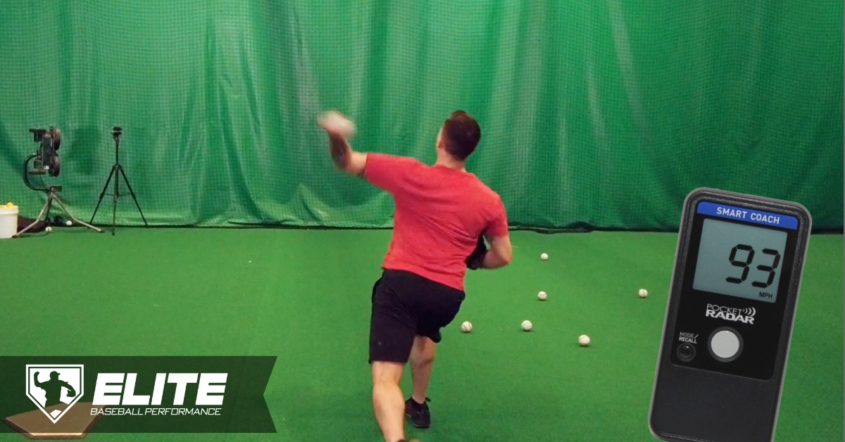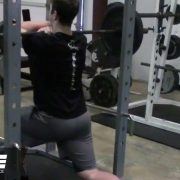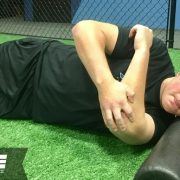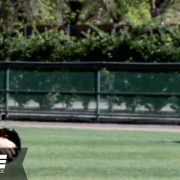3 Ways Baseball Pitchers Can Use a Radar Gun to Enhance Performance
One of the simplest, yet most effective training aids for any baseball pitcher is a radar gun.
At one point in time, I was actually against having youth baseball pitchers use a radar gun too often and focus on velocity, but I actually think that there are a few great benefits. And with recent advances in technology of radar guns, people can easily get an affordable pocket-size radar run, like the Pocket Radar, to use at home.
One of the key differentiators I see between amateur and professional baseball pitchers is often just intent.
What I mean is, our pro ball pitchers tend to throw with much more intent than our younger pitchers. Sure, this could be that pro ball pitchers are older, bigger, and stronger. But intent isn’t just an output of mass and strength. It’s also an output of intensity, which is something many youth need to learn.
Even in our sports performance programs at Champion, our early focus with people new to training is developing intent when training.
So while I don’t necessarily want our amateur baseball pitchers focusing solely on velocity, I still think there are a bunch of great uses of a radar gun during training.
Here are my top 3 ways baseball pitchers can use a radar gun to enhance performance.
Enhance Power Development
Have you ever used a radar gun to check your velocity? No matter what your velocity was on the first throw, what did you every time on that second throw?
Try to throw harder, right? Of course you did, we all do!
In the motor learning world, this is a form of extrinsic feedback referred to as “knowledge of results.” This can be used to give immediate feedback to the player to enhance technique, but also motivation. We see this all the time, especially in athletes who are competitive in nature
We know that using external feedback and knowledge of the results in the sports performance world helps increase power output. For example, in one study using external feedback of results was shown to help improve vertical jump performance. In a 2014 study the Journal of Human Movement Science, it was shown that using feedback of vertical jump height performance results in an immediate increase in vertical jump performance, as well an 18% improvement in jump height over a 4-week training period.
One way that we apply this knowledge with our baseball players is with medicine ball power drills. In this video, you can see we are using a radar gun set up to monitor the ball velocity. The athlete is encouraged to ramp up his intensity on subsequent throws until he reaches his maximum velocity. We’ll record this and try to improve over the course of his program, just like we would by recorded weights during his lifts.
Monitor Throwing Intensity
Another great use of a radar gun for baseball training is to monitor throwing intensity. This is important for a few situations:
- A player returning from an injury that wants to slowly develop load to healing tissue
- A player preparing for a season that wants to slowly build capacity of the arm to handle stress
- A player inseason that wants to manage his workload more specifically
Monitoring the number of throws performed or pitch counts during a game is important, and something that we have shown to correlate to predicting both injury and performance. However, using the quantity of throws on its own is too simplistic. Overuse is more of a combination of quantity and intensity.
Compare one player playing light catch for 30 throws versus another long tossing for 30 throws. Which one do you think was more stressful on the body?
By using a radar gun, you can document and build gradual progressions more appropriately. Distance becomes less of a factor, and intensity becomes more specific.
Here’s an example of how we use a radar gun to ramp up a throwing session. In this video you can see a few throws that slowly ramp up to the max intensity that we want that day. The athlete then does his best to remain right around that velocity to get his work in for the day.
Improve Pitching Velocity
Using a radar gun to help improve pitching velocity is probably the most obvious. When it comes to actually training to enhance pitching velocity, it has been shown that if pitchers know the speed of their pitch during their training, the have a larger increase in velocity.
In a recent study in the Journal of Human Kinetics, it was shown that if players were able to see their throwing velocity, the players were able to enhance their velocity by 4x more than if they did not know their speed. That’s pretty amazing to me, and based off the same mechanisms of motor learning discussed above.
Another past study compared the throwing velocity of youth when instructed to “throw the ball hard” vs the same instruction with radar gun results. Again the study showed that simply instructing the athlete to throw the ball hard does not increase velocity as much as when they can visually see the results.
In another interesting study in tennis players, it was shown that training for 6-weeks with feedback of serve velocity had a significantly greater improvement in velocity than a group that did not know their results. But what is most interesting, is that this same group stopped training with external feedback of their velocity and still showed that the velocity improvements were retained 6 weeks after the program.
What this could mean is that training with the knowledge of your velocity not only helps motivate you to throw harder, but perhaps also trains you to continue to do this even when external feedback is removed.
So while I don’t think amateurs players should always be focusing on enhancing their velocity, I do think there are a few good reasons why the should focus on knowing their velocity. Just like anything else, is the focus is on what is more important, a radar gun can not only be helpful to enhance performance, but also to control and monitor workload.
What Radar Gun Should You Use?
There are a few options when looking at purchasing a radar gun. As you can see from the above examples, I value the convenience of having one on me. So I value one that is portable and easy to use. I’ve personally been using the Pocket Radar and think it’s perfect. We’ve compared it to the more expensive guns, and it’s always just as accurate, but so much easier to use.
The new Smart Coach model is awesome, it can connect to an app on your phone or tablet via bluetooth, or even an external display. This is what we’ve been using at Champion and everyone has loved it.
- Click here to learn more about the Pocket Radar Smart Coach
- Click here to learn more about the Pocket Radar Smart Coach with LED Display
Mike Reinold
Latest posts by Mike Reinold (see all)
- 3 Ways Baseball Pitchers Can Use a Radar Gun to Enhance Performance - April 16, 2019
- 3 Things Baseball Players Need to Develop Elite Pitching Performance - January 15, 2018
- How to Get Your Arm Loose When Throwing Indoors - November 14, 2017











Baseball pitchers must stand straight across from the moving object when using a radar gun. You could be in front of or behind the subject or other person. The ability to maintain an invisible line with the moving object is crucial.